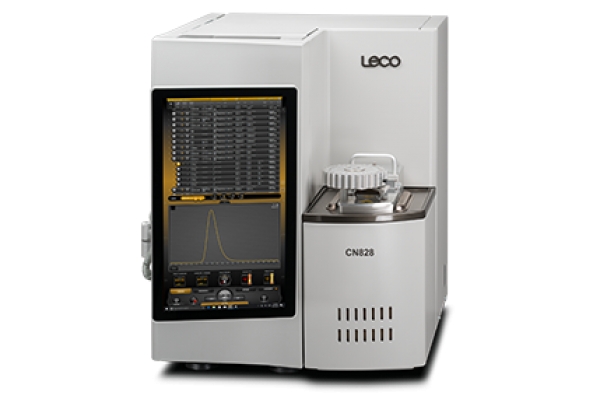828 Series Combustion: Detect Carbon, Hydrogen, Nitrogen, and Protein in Organic Materials
By incorporating state-of-the-art hardware and an on-board, touch-screen software platform, the 828 Series allows you to easily handle a wide range of sample applications. The core capabilities and performance of previous generations of LECO macro combustion instruments have been maintained, while key improvements have been made in throughput, uptime, and reliability. All 828 Series models are compatible with the S832 add-on providing independent sulfur determination. Macro sample mass capability paired with cycle times as fast as 2.8 minutes make the 828 an ideal instrument for a diverse applications base, while delivering unparalleled sample analysis throughput.
Features
- Maximize laboratory productivity with unmatched sample throughput
- Rapid cycle time of 2.8 minutes for added productivity on FP/CN models
- Extended reagent lifetimes optimize instrument up-time
- Easy access to common maintenance areas reduces downtime and time required for routine maintenance.
- Rugged 30-sample autoloader with optional expanded capacity for up to 120 samples maximizes lab efficiency.
- Ergonomic, operator-centered design with boom-mounted touch-screen interface
- Expanded furnace efficiency and reliability with a regent-free design
Applications
The 828 series is ideal for the following applications: Feeds, Pet Foods, Grains and Cereals, Milled Products, Fermentation Products, Dairy Whey and Cheese Products, Soils, Sediments, Fertilizers, Plant Tissue, Waste Materials, Resins and Polymers, Coal and Coke, Biomass Materials, and Petroleum Products and Additives.
Theory of Operation
The 828 Series determines nitrogen/protein, carbon/nitrogen and carbon/hydrogen/nitrogen in a multitude of organic matrices from food/feeds and soils to fuels. The system utilizes a combustion technique with a vertical quartz furnace designed to handle diverse sample matrices with rapid cycle times and extended reagent lifetimes, delivering unsurpassed throughput coupled with superior instrument uptime.
To begin an analysis, the sample is weighed into a tin capsule or encapsulated within tin foil and placed into the loader. A fully-automated analysis sequence transfers the sample to a sealed purge chamber, where atmospheric gas is removed. The purged sample is transferred automatically into a reticulated ceramic crucible within the furnace. To ensure complete and rapid combustion (oxidation) of the sample, the furnace environment is composed of pure oxygen with a secondary oxygen flow being directed to the sample within a reticulated crucible via a quartz lance.
In the FP and CN828 models, the combustion gases are swept from the furnace through a thermoelectric cooler to remove moisture and are collected in a ballast volume. In the CHN828 model, combustion gases are swept from the furnace through an afterburner containing reagent to scrub sulfur compounds from the gas stream prior to collection in the ballast volume. The gases equilibrate and mix within the ballast before a representative aliquot of the gas is extracted and introduced into a flowing stream of inert gas for analysis.
Depending upon the analyzer model, the aliquot gas is carried to a non-dispersive infrared (NDIR) cell for the detection of carbon (as carbon dioxide) and a thermal conductivity cell (TC) to detect nitrogen (N2). In the CHN828 model, the ballast gas is also transferred to a H2O NDIR cell for the determination of hydrogen. Unlike NDIR cells, TC cells are chemically non-specific, so a series of reagents and scrubbers are used to ensure quantitative detection of N2 without chemical interference. A heated reduction tube, filled with copper, is used to convert nitrogen oxide species (NOx) to N2 and remove excess oxygen. Carbon dioxide (CO2) is removed by LECOSORB and water vapor (H2O) is removed by Anhydrone.
The aliquot gas is carried to a non-dispersive infrared (NDIR) cell for the detection of carbon (as carbon dioxide) and a thermal conductivity cell (TC) to detect nitrogen (N2). Ballast gas is also transferred to a H2O NDIR cell for the determination of hydrogen. A heated reduction tube, filled with copper, is used to convert nitrogen oxide species (NOx) to N2 and remove excess oxygen. Carbon dioxide (CO2) is removed by LECOSORB and water vapor (H2O) is removed by Anhydrone. TC cells are chemically non-specific, so a series of reagents and scrubbers are used to ensure quantitative detection of N2 without chemical interference.
Careful sequencing of the analysis provides maximum sample throughput by interleaving the sample loading sequence with quantitation of the aliquot gases from the previous sample.
Many diagnostic sensing capabilities are included in the 828 Series analyzer. Multiple Pressure Transducers (PT) have been included to provide the ability to leak check individual segments of the flow path.
828 Series Details

- FP828
Nitrogen and Protein Analyzer - FP828P
Nitrogen and Protein Analyzer, Performance Package - CN828
Carbon and Nitrogen Analyzer - CHN828
Carbon, Hydrogen, and Nitrogen Analyzer
See how LECO’s FP/CN828 works!
View our operational demonstration video.
- S832 Add-on provides independent Sulfur determination of macro samples
- Cornerstone Mobile [PDF]
- SmartLine Remote Diagnostics [PDF]
- Boom-mounted Touch-Screen Monitor
- Performance Package
FP828 Nitrogen/Protein in Flour [PDF] 小麦粉中の窒素とタンパク質 [PDF]
828 Series [PDF] 828シリーズ [PDF]
Explore Organic Consumables, Reference Materials and Standards

